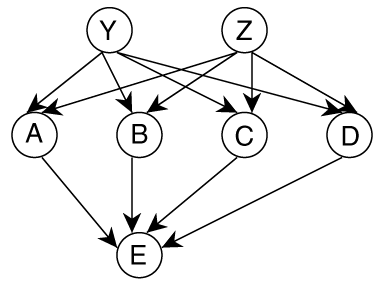| Belief Networks |
We start with a total ordering X1,...,Xn of the random variables.
Definition. The parents of random variable Xi, written piXi, are a minimal1 set of the predecessors of Xi in the total ordering such that the other predecessors of Xi are independent of Xi given piXi. That is piXi subset {X1,...,Xi-1} such that P(Xi|Xi-1...X1) = P(Xi|piXi).
A belief network [22] is an acyclic directed graph, where the nodes are random variables2. We use the terms node and random variable interchangeably. There is an arc from each element of piXi into Xi. Associated with the belief network is a set of probabilities of the form P(X|piX), the conditional probability of each variable given its parents (this includes the prior probabilities of those variables with no parents).
By the chain rule for conjunctions and the independence assumption:
This factorization of the joint probability distribution is often given as the formal definition of a belief network.
P(X1,...,Xn) = PRODi = 1n P(Xi|Xi-1...X1) = PRODi = 1n P(Xi|piXi)

| A | B | C | D | P(e|ABCD) |
| a | b | c | d | 0.55 |
| a | b | c | ~d | 0.55 |
| a | b | ~c | d | 0.55 |
| a | b | ~c | ~d | 0.55 |
| a | ~b | c | d | 0.3 |
| a | ~b | c | ~d | 0.3 |
| a | ~b | ~c | d | 0.3 |
| a | ~b | ~c | ~d | 0.3 |
~a | b | c | d | 0.08 |
~a | b | c | ~d | 0.08 |
~a | b | ~c | d | 0.025 |
~a | b | ~c | ~d | 0.5 |
~a | ~b | c | d | 0.08 |
~a | ~b | c | ~d | 0.08 |
~a | ~b | ~c | d | 0.85 |
~a | ~b | ~c | ~d | 0.5 |
Example.
Consider the belief network of Figure *.
This represents a factorization of the joint probability distribution:
If the variables are binary3, the first term, P(E|ABCD), requires the
probability of E for all 16 cases of assignments of values to
A,B,C,D. One such table is given in Figure *.
P(A,B,C,D,E,Y,Z)
= P(E|ABCD) P(A|YZ) P(B|YZ)P(C|YZ) P(D|YZ) P(Y) P(Z)
| Belief Networks |